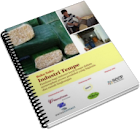 [ By Alique Nursholiqin ] Every morning at 3:30, Ridwan starts making tempeh. He’s been doing this for almost 18 years.
[ By Alique Nursholiqin ] Every morning at 3:30, Ridwan starts making tempeh. He’s been doing this for almost 18 years.“I was making tempeh when I am not yet married. It was in 1991,” the 39-year-old remembers. Today, he’s married to a 35-year-old woman named Isniyati and they have three children; Riski, Riska and Restu.
He feels pride as a tempeh maker, and also sells the tempeh that he produces. “Tempeh is from a Javanese ancestry tradition,” Ridwan says, adding that he originally came from Pekalongan, a north coastal part of Indonesia’s Central Java region.
Not long ago, I went to visit Ridwan at his house in the city of Bekasi to check on the new stove that he’s been using for almost two weeks to cook soybeans. This stove was built at his house as part of a pilot project for Mercy Corps’ Value Initiative Program, which helps small producers save costs as well as protect their environment.
The stove — which can burn using coconut husks and scrap wood as fuel — cooks food in about half the time as traditional cookstoves used in the area. This saves not only firewood, but time for small businessmen like Ridwan.
The stove — which can burn using coconut husks and scrap wood as fuel — cooks food in about half the time as traditional cookstoves used in the area. This saves not only firewood, but time for small businessmen like Ridwan.
According to his wife Isniyati, who helps him cook the soybeans that go to make the tempeh, what once took three hours has now become an hour and thirty minutes. But Ridwan slyly insists that he can prepare a batch even more quickly, in as little time as an hour.
For a hard-working couple like Ridwan and Isniyati, who do all the work themselves as well as take care of the children and perform other household duties, every little bit helps. After all, making tempeh is an intensive three-day endeavor. The first day is the process of washing, cooking and packaging. The second day is fermentation process. Then, on the third day, the tempeh is ready to be sold.
For a hard-working couple like Ridwan and Isniyati, who do all the work themselves as well as take care of the children and perform other household duties, every little bit helps. After all, making tempeh is an intensive three-day endeavor. The first day is the process of washing, cooking and packaging. The second day is fermentation process. Then, on the third day, the tempeh is ready to be sold.
While working in his tempeh kitchen, Ridwan talks to me about his work, and how he came to rely on tempeh making to earn a living. In the beginning, he was only as a worker who helped his relatives. He began to learn much about the process of making tempeh in these days, with an eye on one day starting his own business. Working hard for a few years, Ridwan was finally able to save and buy his own tempeh making equipment.
Today, his tempeh production capacity is 100 kilograms of soybeans per day. Comparatively, this is a small production level for local tempeh makers. That amount of soybeans can make tempeh for 22 trays, each of which contain 24 to 26 pieces He sells his tempeh for 1,500 Indonesian rupiah — about U.S. $0.15 — per piece.
Today, his tempeh production capacity is 100 kilograms of soybeans per day. Comparatively, this is a small production level for local tempeh makers. That amount of soybeans can make tempeh for 22 trays, each of which contain 24 to 26 pieces He sells his tempeh for 1,500 Indonesian rupiah — about U.S. $0.15 — per piece.
If he all his tempeh sells out in a day, he can bring in 850,000 rupiah — or around U.S. $85 in gross income. The cost of production lowers his revenue to about U.S. $66, still more than enough to feed his family, provide for household needs and save a little.
“The rest is for our children’s future," Ridwan says.
Through introduction of these improved stoves to small producers in the area, Mercy Corps is helping save time, money and the environment — which is making a difference for tempeh makers like Ridwan.
“The rest is for our children’s future," Ridwan says.
Through introduction of these improved stoves to small producers in the area, Mercy Corps is helping save time, money and the environment — which is making a difference for tempeh makers like Ridwan.
“I feel satisfied with the new stove that it is faster and better, with less time to cook soybeans that can reduce my work time to make tempeh,” he says. “Now I can rest more and be with my kids”.




























3 comments:
nice story!
what is the different between tempeh and tempe?
1st anoname: Thank you.
2nd anoname: Tempeh is tempe its self. the original name of tempeh is tempe (original Javanis language, Indonesia). most of western people call it tempeh, maybe to make different with Tempe, a name of a town in US. Thank you
Posting Komentar